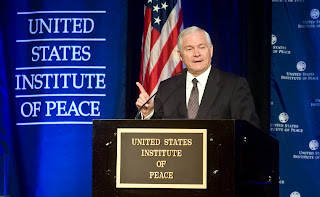
From the latest news it would appear that the conflict in Afghanistan is moving into a new and more deadly phase.
On October 16, 2008 SecDef remarked ““Afghanistan is the test, on the grandest scale, of what we are trying to achieve when it comes to integrating the military and the civilian, the public and private, the national and international,” at the U.S. Institute of Peace’s first Dean Acheson lecture. (more details at:
http://www.defenselink.mil/news/newsarticle.aspx?id=51524)
The DoD story notes that: “Gates called Afghanistan “the laboratory” for U.S. efforts to apply and fully integrate the full range of its national power and international cooperation to protect its security and vital interests.
SecDef Gates described the scope of the effort there, as 42 nations, hundreds of nongovernmental organizations, universities, development banks, the United Nations, the European Union and NATO all working together to help Afghanistan rise above the challenges it faces. These range from crushing poverty to a bumper opium crop to a ruthless and resilient insurgency and al-Qaida and other violent extremists.
“Afghanistan has tested America ’s capacity – and the capacity of our allies and partners – to adapt institutions, policies and approaches that in many cases were formed in a different era for a different set of challenges,” Gates said.”
Gates concluded that there were two key ingredients needed for success in Afghanistan:
“To be successful, the entirety of the NATO alliance, the European Union, NGOs and other groups – the full panoply of military and civilian elements – must better integrate and coordinate with one another and also with the Afghan government,” he said. “These efforts today, however well-intentioned and even heroic, add up to less than the sum of the parts.”
“A big factor in Afghanistan ’s success rests in the effort to rapidly train, equip and advise its army and police force”, Gates said. He noted that until recently, few Western governments and militaries had this capability outside their Special Forces.
After my personal experience of working alongside my NATO colleagues in Sarajevo, and switching to ‘civilian mode’ when walking the halls of the Office of the High Representative (OHR), I can attest to the fact that once again the SecDef has hit the nail on the head. The synergy of the Coalition, NGOs and other organizations is the weapon needed to defeat extremism. The application of resources to address the social, economic and infrastructure needs of the country is the mode of attack for nation building.
However, doing the work is only part of the solution. The Afghani people must understand that the Coalition is working together for their common good. This is where PSYOP comes in. working in tandem with PAO, and Strategic Communications, PSYOP must be employed to make certain that the people know the source of their new resources.
Herein lies the challenge, under the current stove pipe organization each element within the USG answers to its own master as to the corresponding components from other nations and other organizations. There is a critical need to form as SecDef calls it, “a laboratory” to orchestrate the information engagement in an unprecedented way and in a commercial flavored manner. This organization would likely report to Department of State, but would be a hybrid of US, other nations and NGOs, etc. The leadership would be a respected civilian, ideally one with credible backgrounds in the military and commercial sectors and with the diplomatic skills required to ‘herd the cats’.
As example, there was a September Medical Assistance Mission in Arghandab district of Afghanistan’s Kandahar province. According to one of the officers on that mission: “We were expecting roughly 400 people to come through, but approximately 850 showed up, 500 of which were kids,” the officer said. “We had to go back to the firebase to get more supplies to hand out to meet the overwhelming demand. Everyone that came in walked away with something that they needed. I’m just glad we could do something to make their lives a little better.” (More details at:
http://www.defenselink.mil/news/newsarticle.aspx?id=51528).
It’s great to read about such a heartwarming story on the official DoD website, but how would Afghanis down the road or across the street know this happened? How would the best practices and lessons learned from this mission and the publicity surrounding it be spider webbed to other similar missions in Afghanistan or even Iraq? These are the questions that need to be answered in the next phase of this conflict.









